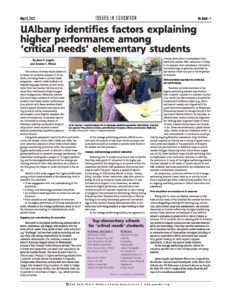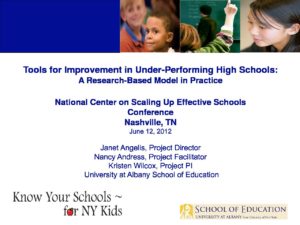Publication Year: 2012
This article describes the work of the NYKids project to identify factors explaining higher performance among critical needs elementary students. Critical needs students include those with special needs and English Language Learners, as well as those living in poverty and students from traditionally disadvantaged racial backgrounds.
This article describes the work of the NYKids project to identify factors explaining higher performance among critical needs elementary students. Critical needs students include those with special needs and English Language Learners, as well as those living in poverty and students from traditionally disadvantaged racial backgrounds. Results of study suggest factors include: (1) close engagement with and understanding of students; (2) literacy- and technology-enriched instruction; (3) an evidence-based approach to curriculum and performance; and (4) fluid adaption and deployment of resources.
This presentation provides an overview of the ongoing NYKids project. The mission of the project is to inform, inspire and improve by providing research in support of school improvement efforts.
This presentation provides an overview of the ongoing NYKids project. The mission of the project is to inform, inspire and improve by providing research in support of school improvement efforts.
This presentation presents findings from the NYKids project on higher-performing secondary schools as measured by the school’s record of educating vulnerable young people such as those living in poverty.
This presentation presents findings from the NYKids project on higher-performing secondary schools as measured by the school’s record of educating vulnerable young people such as those living in poverty. Across all levels- elementary, middle, high – higher-performing students come from schools with the capacity for continuous improvement. These schools do this through: (1) distributed leadership; (2) collaborative culture and practices; (3) evidence-based decision making; and (4) shared vision and goal setting.
This presentation describes the school improvement process and tools connected to the NYKids research studies.
This presentation describes the school improvement process and tools connected to the NYKids research studies.
This presentation describes the COMPASS process. The process involves harnessing the research generated through the NYKids project for the purpose of school improvement.
This presentation describes the COMPASS process. The process involves harnessing the research generated through the NYKids project for the purpose of school improvement. Schools participate in COMPASS Institutes and utilize COMPASS tools. COMPASS stands for: (1) COMPare practices to higher performance; (20 Assess priorities; (3) Select potential levers to improve; and (4) Set Smart goals.





